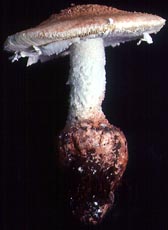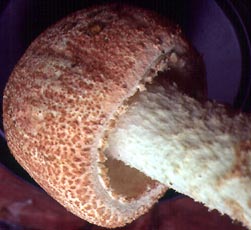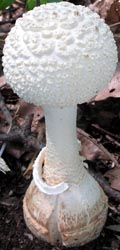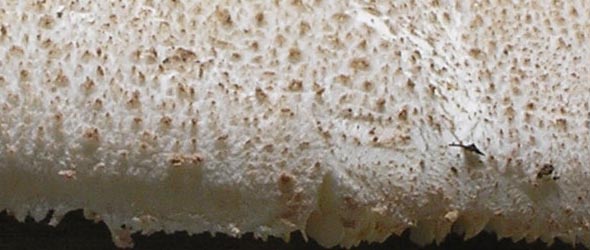[ Section Lepidella page. ]
[ Amanita Studies home. ]
[ Keys & Checklist/Picturebooks ]
[ Great Smoky Mtns. N.P. & region list ]
[ New Jersey & region list ]
[ E. Texas & Gulf Coast list ]
"Carrot-footed Lepidella"




Technical description (t.b.d.)
The cap of Amanita daucipes is 89 - 200 mm wide, white or very pale sordid beige (and then darker in the center). The cap is subhemispheric at first, then convex. It is dull when dry and sometimes cracks so that each wart is in the center of a region bounded by cracks. The flesh is white, not staining/bruising when cut, but slowly becoming pink and then more or less dark brick red in old wounds; it is more or less 7 mm thick over the stipe, and thins evenly to the cap margin. The margin is not striate; it is appendiculate with segments of partial veil or with flocculose material. The volva on the cap takes a variety of forms -- thick cake-like warts and/or narrow subconic or small pyramidal warts sometimes connected at tips suggesting decoration on some Lycoperdon spp.; toward the cap margin, the warts becoming smaller. At first the warts are white to pale pinkish. They then become pinkish beige to pinkish to reddish pink; with age, they become pallid on the sides and grayish on top; and they are easily removable.
The gills of this species are free (or occasionally very narrowly adnate), without a decurrent line on the stipe; they are close to subcrowded, cream in mass, pale yellow or pale yellowish cream in side view. They are about as broad as the thicknesss of the pileus above the stipe (e.g., 12 mm broad); and their margins are flocculose (lens). The short gills are truncate to attenuate, plentiful, unevenly distributed, and of many lengths.
The stem of A. daucipes (excluding the bulb) is 55 - 193 × 9 - 25 mm, white, decorated with white to pale pinkish to pink flocculence (easily removed on one's fingers when a fresh specimen is handled), with flocculence often densest in upper half (approximately). The stipe's bulb is 60 - 150 × 31 - 60 mm, radicating, irregularly napiform or irregularly turbinate or dauciform, infrequently potatoe-like; it is also often marked with longitudinally oriented clefts and has a surface that often stains/bruises strongly vinaceous or reddish vinaceous at maturity. The context of the stem is solid, mostly white or cream-white, not staining or bruising rapidly, but eventually staining/bruising, with old wounds colored as in the case of the pileus. The partial veil of A. daucipes is superior to subapical to apical, white, submembranous-felted, tearing, striate above, flocculose-fibrillose below, and with underside having some or many flocculose pinkish areas; it commonly falls from the stipe by maturity of the mushroom. The volva is usually absent on the stipe's bulb. On the other hand, there are often parts of the volva's intenal limb remaining as a loose, rather thick, felted ring around the base of the stipe (lying on the top of the bulb) or as a rather robust felted patch or patches in roughly the same position; these remnants are pinkish brown to white with pinkish regions.
The odor is strong and sweetish or nondescript in young material and meat-like to “old ham” or decaying protein in older material. To my knowledge, the taste has not been recorded.
The spores measure (8.0-) 9.1 - 11.5 (-13.8) x 5.5 - 7.2 (-9.9) µm and are ellipsoid to elongate (infrequently broadly ellipsoid) and amyloid. Clamps are present at bases of basidia.
The species occurs with oak (Quercus) or in mixed pine (Pinus)-oak forest. Hickory <->(Carya)and birch <->(Betula) are also sometimes found nearby.
The range of the species extends from the eastern part of the U.S.A. to the neo-volcanic zone of central Mexico.
WARNING: I have been told on a number of occasions that the stipe's bulb is edible. Considering the poor knowledge of toxins in section Lepidella and the established fact that kidney and/or liver failure is associated with ingestion of species in section Lepidella, I cannot recommend that this species be eaten. -- R. E. Tulloss
Photos: R. E. Tulloss (first row center and right - New Jersey, left - West Virginia; second row - New Jersey)
[ Section Lepidella page. ]
[ Amanita Studies home. ]
[ Keys & Checklist/Picturebooks ]
[ Great Smoky Mtns. N.P. & region list ]
[ New Jersey & region list ]
[ E. Texas & Gulf Coast list ]
Last change 7 March 2009.
This page is maintained by R. E. Tulloss.
Copyright 2003, 2006, 2008, 2009 by Rodham E. Tulloss.
Photographs copyright 2003 and 2006 by Rodham E. Tulloss.